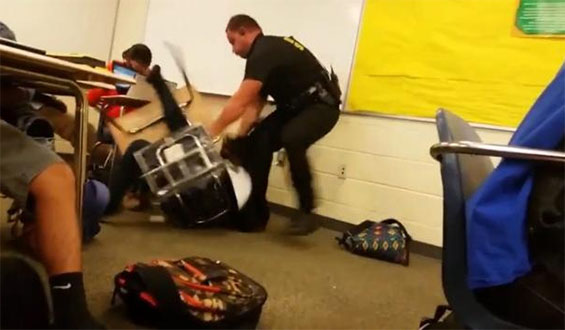Education
What If South Carolina’s Body-Slammed Teen Had Been Treated Restoratively?

By Julia Steiny
Restorative practices are simple tools for handling conflict in ways that maximize the possibility of a happy ending. The practices are habits of the mind and heart. So let’s revisit last October’s nasty incident at Spring Valley High with an eye on how things might have gone differently if the school had been Restorative.
Likely you remember the cellphone videos that went viral, showing a math class where a teenage girl’s non-compliance triggered a violent assault by a School Resource Officer (SRO). The attack on her would have been appalling under any circumstances, but to boot, the uniformed police officer was white and the girl was black.
The girl’s classmates reported that she had pulled out her cellphone, a bane of many schools’ existence these days. Adolescents are by nature easily distracted, but this generation has been raised in part by electronic baby sitters, so their phones are not just interesting, but comforting. Was the girl unprepared or feeling stupid in this algebra class? We don’t know. We know she was distracted and distracting.
The 16-year veteran teacher asked her to put it away. She refused. He asked her to go to the “discipline office.” She refused again, so he got the SRO. The videos show her clinging to the chair in defiance of the officer. But he totally lost his stuff. After slamming her to the ground, he threw her out the door. He was fired soon after. The reports mostly focus on him.
Restorative schools are trauma-informed.
Among the few facts revealed about the girl was that she was in foster care. A state’s Child Protective Services remove kids from their homes when the parents are abusive, seriously neglectful, substance abusers, radically incompetent, or dead. So foster-care kids have been traumatized, if only by being removed. They have precious little control over their lives. The girl asserted what power she had. Neither the cop nor the teacher necessarily knew the girl’s circumstances, nor do most school staff need to know kids’ personal business. But “trauma-informed” means that adults are fully aware that such circumstances are always possible – with any kid.
In other words, when confronting nasty behavior, the safe assumption is that it could be signaling the presence of trauma. If so, the trauma can be ignited by yelling, humiliating, or generally getting into a head-butt with someone unwilling to comply with orders. When trauma overwhelms a person, their brain shuts off its language center and executive function, leaving the body and primitive parts of the brain to defend itself with primitive methods. They can not use their words appropriately. So getting into a power struggle with a traumatized kid risks triggering out-of-control behavior. Better to tread lightly and assume that the kid may not be capable of responding appropriately.
Ask three caring, de-escalating questions first.
Mind you, nothing excuses a student for disrupting a class. The rest of the class deserves to learn. But punitive techniques like kicking the kid out often exacerbate the problem.
Restorative 101 would recommend speaking to a misbehaving kid, like the girl with the phone, in a calm, lowered voice — always a good de-escalating tactic. And instead of making commands or statements, ask a couple of questions in a caring, sincere, non-sarcastic tone. Questions such as:
“Are you expecting an important call?” This calls the kid out for her behavior. Some people object that such call-outs are themselves embarrassing. But the kid clearly needs help seeing that what she’s doing has a negative effect on the classroom community. She’s made her behavior their business. No reason to be mean, but does she understand what the big picture looks like? A tiny prick of shame is okay, especially if it helps her put her phone in her pocket.
“Is there something going on with you today that’s distracting you? If so, I’ve got a minute after class to talk.” Most kids are going to say no whatever the circumstances. But if the teacher is available after class, perhaps with one more kind question, at least the kid might feel cared about. Maybe she’ll say something pertinent.
Or: “Can the phone wait? This is algebra and we all need to concentrate.”
The SRO might have been entirely unnecessary.
Granted, teachers don’t feel they have time to ask such questions. Some feel a disruptive kid doesn’t deserve helpful attention. But a moment of caring might have made a huge difference to our foster-care teen. And an argument that leads to a kick-out disrupts the class hugely. A few quick questions can make it clear whether the kid can settle into class or truly needs to be elsewhere.
The point is that a gentle, trauma-informed approach can de-escalate and prevent conflicts. Restorative practices can’t guarantee redeemed behavior. But they do create the conditions that ease trouble instead of throwing gas on what might well be a smoldering ember. The girl was apparently quiet, if breaking the rules. She deserved to be treated restoratively. As do they all.
Author information
The post What If South Carolina’s Body-Slammed Teen Had Been Treated Restoratively? appeared first on Education News.


Comments (0)